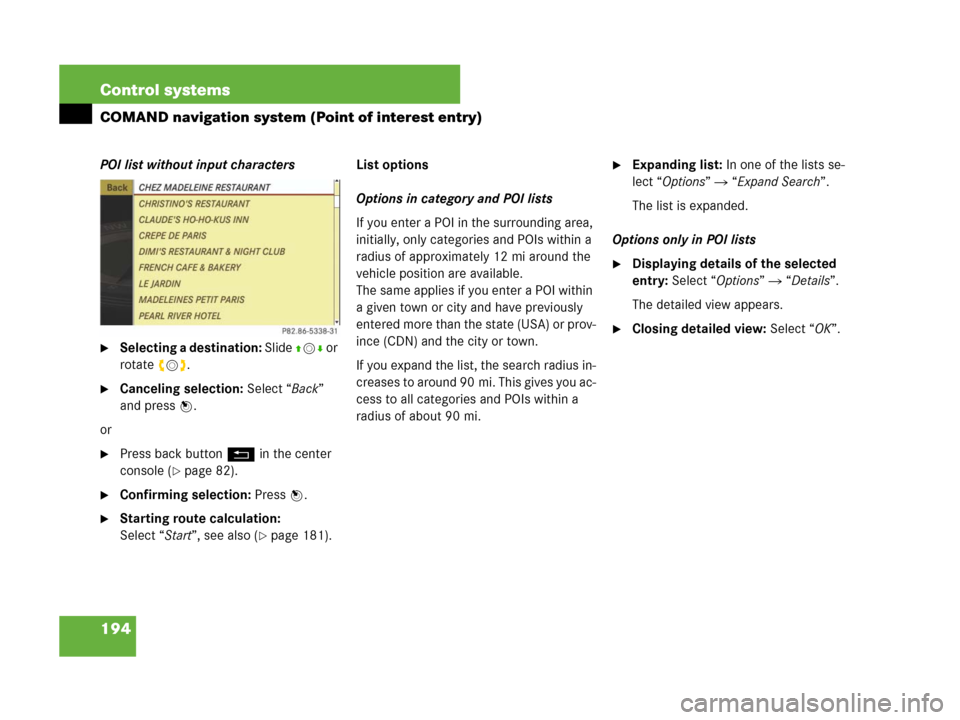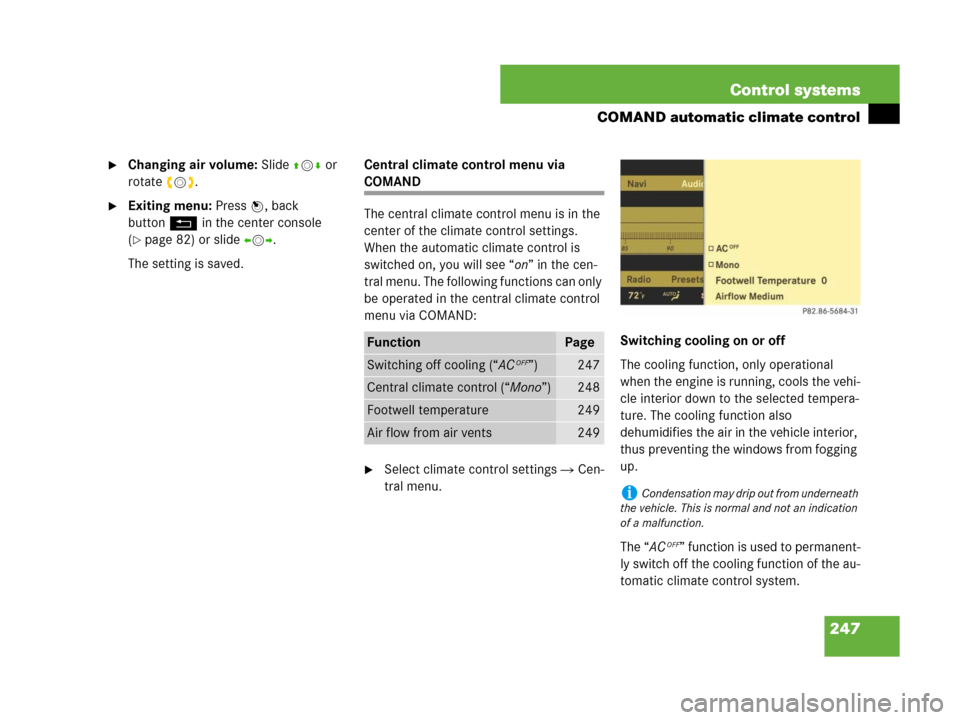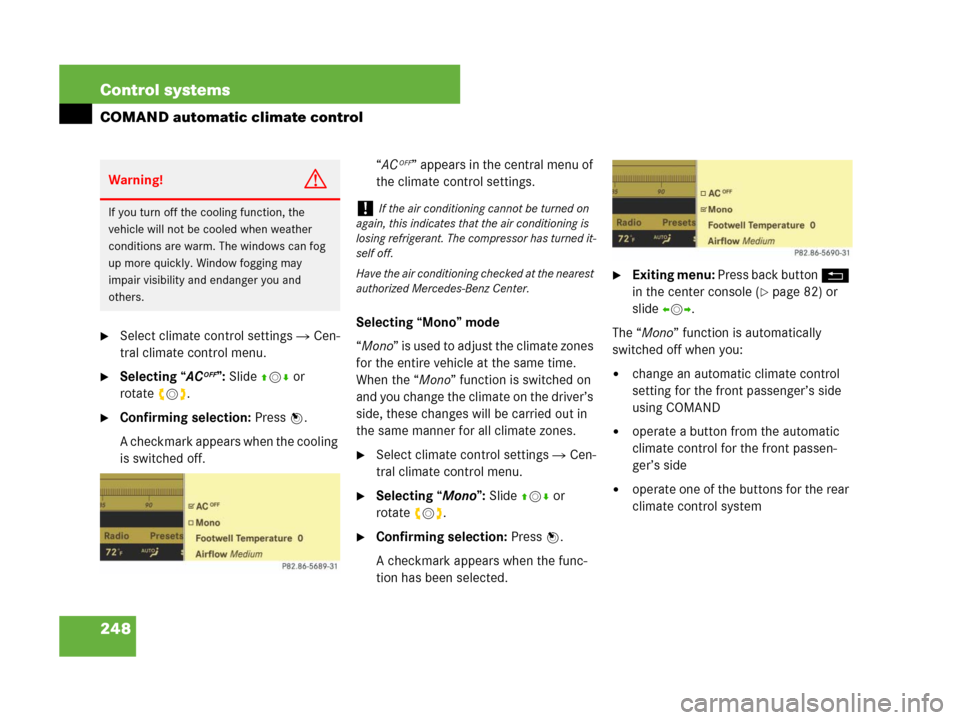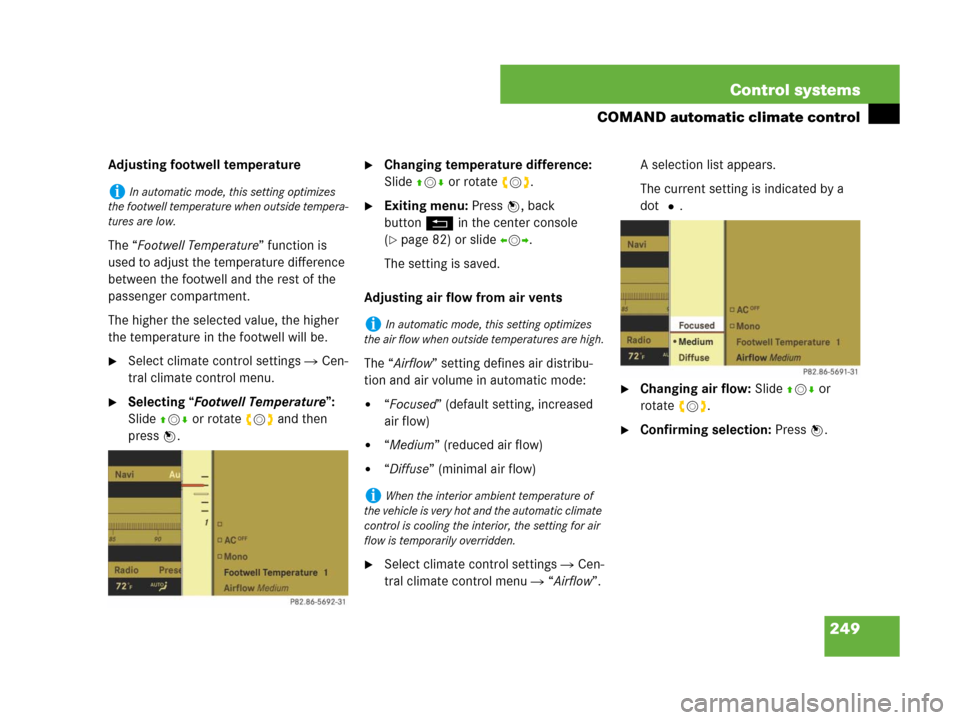Page 195 of 723

194 Control systems
COMAND navigation system (Point of interest entry)
POI list without input characters
�Selecting a destination: Slide qmr or
rotate ymz.
�Canceling selection: Select “Back”
and press n.
or
�Press back button L in the center
console (
�page 82).
�Confirming selection: Press n.
�Starting route calculation:
Select “Start”, see also (
�page 181).List options
Options in category and POI lists
If you enter a POI in the surrounding area,
initially, only categories and POIs within a
radius of approximately 12 mi around the
vehicle position are available.
The same applies if you enter a POI within
a given town or city and have previously
entered more than the state (USA) or prov-
ince (CDN) and the city or town.
If you expand the list, the search radius in-
creases to around 90 mi. This gives you ac-
cess to all categories and POIs within a
radius of about 90 mi.
�Expanding list: In one of the lists se-
lect “Options” � “Expand Search”.
The list is expanded.
Options only in POI lists
�Displaying details of the selected
entry: Select “Options” � “Details”.
The detailed view appears.
�Closing detailed view: Select “OK”.
Page 205 of 723

204 Control systems
COMAND navigation system (during route guidance)
Displaying route information
�Select “Route” � “Route Info” in map
view with the menu system displayed
(
�page 157).
The route information appears.
Example display with main destination and
stopover
1Distance to the destination
2Symbol = for stopover
3Abbreviation for province (CDN) or
state (USA)
4Town/city
5Street
6Symbol < for main destination
7Estimated driving time to the destina-
tion
8Estimated arrival time
�Closing route info: Slide omp or
press back button L in the center
console (
�page 82).
iCOMAND uses the time set in COMAND as
the basis for calculating the estimated arrival
time. The clock must be set correctly in
COMAND (
�page 227). The calculation of the
estimated arrival time does not additionally take
into account whether Daylight Saving Time or
standard time is applicable at the destination. If
the destination is in a different time zone, arrival
time display
8 is in local time. This is indicated
by “LT” in the display.
The following data cannot be seen until the route
calculation has been completed:
�Distance to destination 1
�Estimated arrival time 8
�Estimated remaining travel time 7
If the destination is located within a partially dig-
itized area, the following data may differ from the
facts:
�Distance to destination 1
�Estimated arrival time 8
�Estimated remaining travel time 7
Page 244 of 723

243 Control systems
COMAND vehicle menu
�Confirming selection: Press n.
or
�Select “Vehicle” � “Vehicle” � “Trunk
Opening-height Restriction”.
A checkmark appears when the trunk
opening-height restriction is switched
on.
�Confirming selection: Press n.
Switching the tow-away alarm on/off
Depending on vehicle production date,
your vehicle may not be equipped with the
tow-away alarm.
To prevent triggering the tow-away alarm
feature (
�page 78), switch off the
tow-away alarm before towing the vehicle,
or when parking on a surface subject to
movement, such as a ferry or auto train.
�Select “Vehicle”.
The main area is active.
�Selecting “Tow-away Alarm” func-
tion: Slide omp or rotate ymz.
�Confirming selection: Press n.or
�Select “Vehicle” � “Vehicle” �
“Tow-away Alarm”.
A checkmark appears when the
tow-away alarm is switched on.
�Confirming selection: Press n.
iThe components and operating principles of
COMAND can be found on (
�page 81).
iYou can program the tow-away alarm func-
tion (
�page 231) using the favorite button in the
center console.
When you press the favorite button, you can
switch the functions on or off.
Page 246 of 723
245 Control systems
COMAND automatic climate control
The automatic climate control menu is
called up via the climate control settings.
Climate control settings with functions
(submenus)
1Temperature, left
2Air distribution, left
3Air volume, left
4Central menu, climate control
5Air volume, right
6Air distribution, right
7Temperature, right
Setting temperature
Use the temperature controls %$
(
�page 453) in the center console or
COMAND climate control settings to sepa-
rately adjust the air temperature on each
side of the passenger compartment.
�Select climate control settings � Tem-
perature, left or right and then
pressn.
�Changing temperature: Slide qmr or
rotate ymz.
�Exiting menu: Press n, back
buttonL in the center console
(
�page 82) or slideomp.
The setting is saved.
Page 247 of 723
246 Control systems
COMAND automatic climate control
Adjusting air distribution
You can adjust the air distribution sepa-
rately for the driver’s and front passenger’s
side.
�Select climate control settings � Air
distribution, left or right.
�Changing air distribution:
Rotateymz.
The symbol for air distribution changes.
The direction and size of the arrows
represent the air distribution.
�Exiting menu: Press n, back
buttonL in the center console
(
�page 82) or slideomp.
The setting is saved.
Adjusting air volume
Use buttonsQ (
�page 453) in the cen-
ter console or COMAND climate control
settings to separately adjust the air vol-
ume on each side of the passenger com-
partment.
�Select climate control settings � Air
volume, left or right.
iWhen you change the air distribution, the au-
tomatic function of the climate control system is
switched off.
iWhen you change the air volume, the auto-
matic function of the climate control system is
switched off.
Page 248 of 723

247 Control systems
COMAND automatic climate control
�Changing air volume: Slide qmr or
rotate ymz.
�Exiting menu: Press n, back
buttonL in the center console
(
�page 82) or slideomp.
The setting is saved.Central climate control menu via
COMAND
The central climate control menu is in the
center of the climate control settings.
When the automatic climate control is
switched on, you will see “on” in the cen-
tral menu. The following functions can only
be operated in the central climate control
menu via COMAND:
�Select climate control settings � Cen-
tral menu.Switching cooling on or off
The cooling function, only operational
when the engine is running, cools the vehi-
cle interior down to the selected tempera-
ture. The cooling function also
dehumidifies the air in the vehicle interior,
thus preventing the windows from fogging
up.
The “AC
OFF” function is used to permanent-
ly switch off the cooling function of the au-
tomatic climate control system.
FunctionPage
Switching off cooling (“ACOFF”)247
Central climate control (“Mono”)248
Footwell temperature249
Air flow from air vents249
iCondensation may drip out from underneath
the vehicle. This is normal and not an indication
of a malfunction.
Page 249 of 723

248 Control systems
COMAND automatic climate control
�Select climate control settings � Cen-
tral climate control menu.
�Selecting “ACOFF”: Slide qmr or
rotateymz.
�Confirming selection: Press n.
A checkmark appears when the cooling
is switched off.“AC
OFF” appears in the central menu of
the climate control settings.
Selecting “Mono” mode
“Mono” is used to adjust the climate zones
for the entire vehicle at the same time.
When the “Mono” function is switched on
and you change the climate on the driver’s
side, these changes will be carried out in
the same manner for all climate zones.
�Select climate control settings � Cen-
tral climate control menu.
�Selecting “Mono”: Slide qmr or
rotateymz.
�Confirming selection: Press n.
A checkmark appears when the func-
tion has been selected.
�Exiting menu: Press back button L
in the center console (
�page 82) or
slideomp.
The “Mono” function is automatically
switched off when you:
�change an automatic climate control
setting for the front passenger’s side
using COMAND
�operate a button from the automatic
climate control for the front passen-
ger’s side
�operate one of the buttons for the rear
climate control system
Warning!G
If you turn off the cooling function, the
vehicle will not be cooled when weather
conditions are warm. The windows can fog
up more quickly. Window fogging may
impair visibility and endanger you and
others.!If the air conditioning cannot be turned on
again, this indicates that the air conditioning is
losing refrigerant. The compressor has turned it-
self off.
Have the air conditioning checked at the nearest
authorized Mercedes-Benz Center.
Page 250 of 723

249 Control systems
COMAND automatic climate control
Adjusting footwell temperature
The “Footwell Temperature” function is
used to adjust the temperature difference
between the footwell and the rest of the
passenger compartment.
The higher the selected value, the higher
the temperature in the footwell will be.
�Select climate control settings � Cen-
tral climate control menu.
�Selecting “Footwell Temperature”:
Slide qmr or rotate ymz and then
pressn.
�Changing temperature difference:
Slide qmr or rotate ymz.
�Exiting menu: Press n, back
buttonL in the center console
(
�page 82) or slideomp.
The setting is saved.
Adjusting air flow from air vents
The “Airflow” setting defines air distribu-
tion and air volume in automatic mode:
�“Focused” (default setting, increased
air flow)
�“Medium” (reduced air flow)
�“Diffuse” (minimal air flow)
�Select climate control settings � Cen-
tral climate control menu � “Airflow”.A selection list appears.
The current setting is indicated by a
dotR.
�Changing air flow: Slide qmr or
rotateymz.
�Confirming selection: Press n.
iIn automatic mode, this setting optimizes
the footwell temperature when outside tempera-
tures are low.
iIn automatic mode, this setting optimizes
the air flow when outside temperatures are high.
iWhen the interior ambient temperature of
the vehicle is very hot and the automatic climate
control is cooling the interior, the setting for air
flow is temporarily overridden.